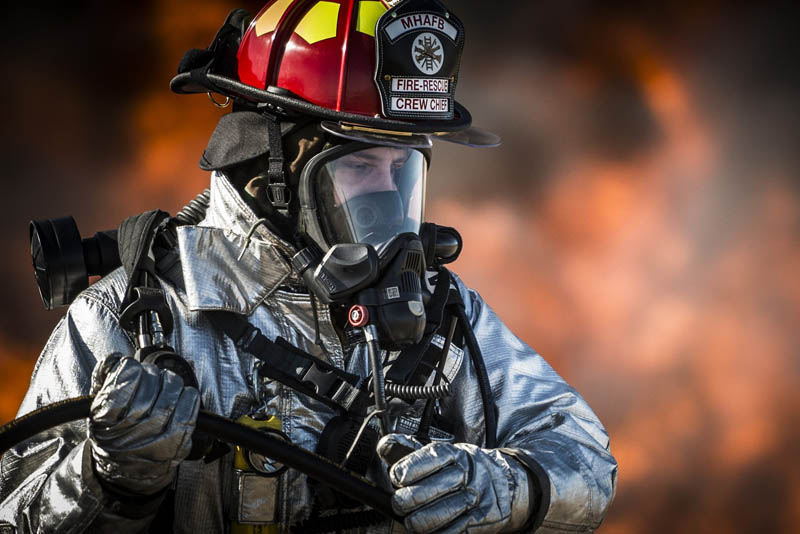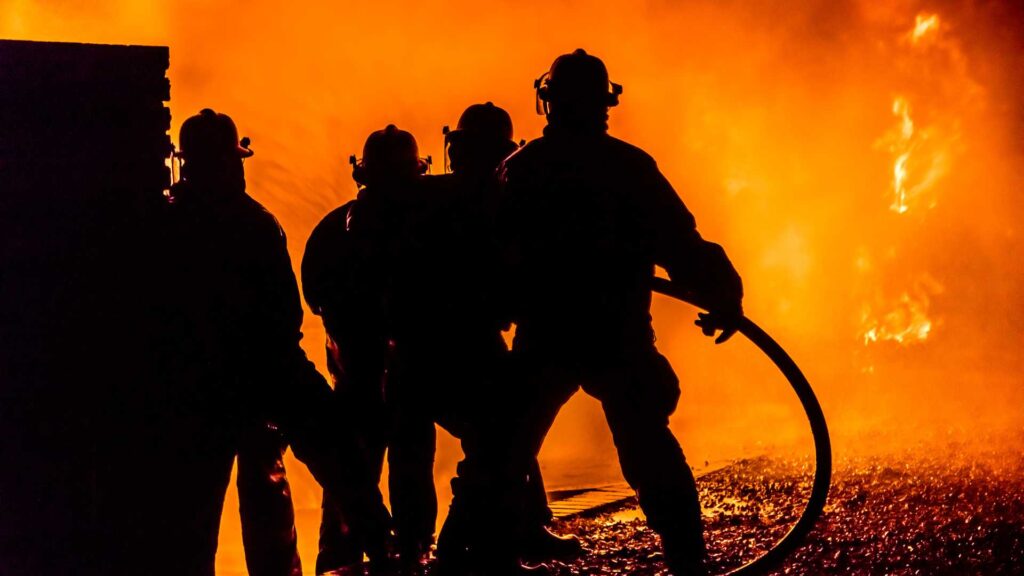
Inhalation or ingestion of airborne asbestos fibers can occur when disturbed or worn-down materials containing the mineral are disturbed. Once they get into the lungs or digestive system tissues, they can remain there forever. Over time, these fibers can cause mesothelioma, a rare and aggressive form of cancer, as well as other deadly diseases. Unfortunately, many jobs pose a greater risk of asbestos exposure.
8 Jobs with Asbestos Exposure Risk

While asbestos has been made illegal to use, there are still many industries that come across it.
1. Firefighters
Asbestos-containing products still lurk in many older buildings, and firefighters are twice as likely to develop mesothelioma than the general public.
From 2015 to 2020, an alarming 75% of firefighters added to the IAFF’s Memorial for Fallen Firefighters died from workplace-related cancer.
Due to the lack of advanced warning that hazardous materials may be present in a responder’s environment, firefighter responses tend to be significant.
It is essential that we recognize the risks that firefighters face every day and take steps to ensure their safety while they work hard to protect us all.
2. Construction Workers
The number of construction workers in the United States in 2019 was estimated at 11.4 million, according to the Centers for Disease Control and Prevention (CDC), making them a crucial part of the American economy.
Unfortunately, many of these workers face a unique hazard: asbestos exposure. Asbestos was used in building materials for decades due to its ability to make products lighter, more robust, and fireproof.
As a consequence, a large amount of commercial, industrial and residential architecture constructed between the 1920s to 1980s used asbestos-based materials, which remain today.
Common construction materials that may contain asbestos include:
- insulation
- roofing shingles
- floor tiles
- ceiling tiles
- drywall joint compound
- and plaster.
Inhaling or ingesting airborne asbestos fibers can cause serious health problems such as mesothelioma and lung cancer. Therefore it is essential for construction workers to take precautions when working on buildings that may contain asbestos-containing materials.
This includes wearing protective clothing such as respirators or face masks, as well as avoiding activities that could disturb the material and release fibers into the air.
Additionally, employers should provide training on how to safely handle asbestos-containing materials and ensure that all employees are aware of the risks associated with
3. Auto Mechanics
Due to their work with worn car parts, auto mechanics and brake technicians are in danger of asbestos exposure.
Many of these parts, such as clutch facings, brake shoes, linings, and other friction materials were made with asbestos before the early 1980s. With approximately 750,000 auto technicians and mechanics, many have endured years of asbestos exposure at repair shops.
Some automobile parts manufacturers still insist that asbestos is safe when adequately contained, despite the overwhelming evidence to the contrary.
This means that auto mechanics and brake mechanics may still be exposed to this dangerous material even today. It is essential for those who work in this field to take extra precautions when handling any materials that may contain asbestos in order to protect themselves from potential health risks associated with its inhalation or ingestion.
4. Insulators
Insulators are skilled professionals who work with thermal insulation materials in residential, commercial and industrial buildings. They handle installation, maintenance, and replacement of these materials.
This is an essential job as it helps to regulate the temperature of a building or facility, making it more comfortable for people inside. Insulators also help to reduce energy costs by keeping heat from escaping through walls and ceilings.
Individuals who work with buildings or machines made prior to the 1980s may be in danger of asbestos exposure.
Asbestos was commonly used as insulation material prior to this period and can cause serious health problems if inhaled or ingested. Insulators who may be at risk include those who work at apartment complexes, chemical plants, and factories. It is essential for these workers to take safety precautions when dealing with potentially hazardous materials such as asbestos. Wearing protective clothing and respirators can help minimize the risk of exposure.
5. Plumbers
The work of plumbers puts them at a greater risk of being exposed to asbestos.
Plumbers who work in homes or businesses under renovation are likely to come into contact with old asbestos-containing components and materials such as cement pipe, hot water pipes, joint compounds, adhesives and sealants, and lagging in wall cavities. Asbestos is a hazardous material that can cause serious health problems if inhaled or ingested.
It is essential for plumbers to take extra precautions when working with any materials that may contain asbestos. This includes wearing protective clothing such as respirators, gloves, and coveralls. Additionally, plumbers should avoid creating dust by wetting down surfaces before cutting or drilling into them.
Before beginning any plumbing work, it is best to have a professional assess the area for potential asbestos contamination. By taking these steps, plumbers can help protect themselves from the dangers of asbestos exposure.
6. Electricians
Electricians are often exposed to asbestos while on the job, as it was commonly used in electrical equipment due to its fire protectant and heat-resistant qualities. Asbestos can be found in many places that electricians may encounter while working, such as attics or basements. Everyday products containing asbestos that electricians may come into contact with include ceiling tiles and cement siding.
Asbestos exposure can be dangerous for electricians, as it is a known carcinogen and can cause serious health problems if inhaled or ingested.
It is essential for electricians to take precautions when working with any materials that may contain asbestos, such as wearing protective clothing and using respirators. Additionally, they should always check with their employers to ensure that any materials they are working with have been tested for asbestos content before beginning work.
7. Military Service Members & Veterans
Military service members and veterans are at an exceptionally high risk of developing mesothelioma due to their exposure to asbestos during their time in the military.
Veterans who had been exposed to asbestos during their military service were, in addition, at risk for continued exposure to this hazardous material as they moved into civilian occupations that were similar.
This means that veterans are even more likely than other individuals to develop mesothelioma due to their prolonged exposure over a more extended period.
Over 30% of mesothelioma patients are veterans of the U.S. Armed Forces, particularly those who served in the U.S. Navy, making it clear that this is a severe issue for our nation’s heroes.
8. Teachers
Asbestos exposure is a severe health risk, and teachers are at risk of being exposed to it without even knowing. According to the EPA, about 20% of public buildings in the United States contain asbestos, which amounts to over 730,000 structures including many public schools. This is why some researchers believe that mesothelioma in women is increasing- teachers are mostly women and schools in our country are old.
Due to their frequent stays within the school building, teachers may unknowingly be exposed to asbestos.
